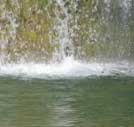Water in the Dynamic Yoga Method
WATER: THE ELEMENT OF FLUIDITY
Water qualities are movement, flowing, connecting, exchanging, adaptability, power and feeling. The fundamental expression of water is movement, and it is embodied in the technique of entering and leaving, arriving and departing: vinyasa. The arena of water is the pelvis, its source the ball of the foot, its medium the bones, and its key the joints. It is cultivated and expressed by learning to move softly and fluidly into, out of and between asana. It is supported by repetition, and expressed in synchronicity between breath and body movement.
The superficial application of water is to allow complete passivity into the muscular system, reducing asana to stretch. By subtracting muscular contraction from the body's response to gravity the laod it is designed to carry is taken by the connective tissue. This subjects them to stress that soon becomes strain and damage. Damage that can be so incremental and masked by endoprhin activity and inattentiveness that it is unrecognised or disowned. The body then falls deeper into its structural imbalances and masks further its inherent integrity.
The subtle application of water is to synchronise body movement with breathing. This unites body, breath and mind, by inviting breathing to support movement and movement to generate breathing. Establishing water requires the utilisation of sensitivity, the sign of its presence is its opposite, power. Without vinyasa we will not be able to fully utilise asana. It determines the quality of any posture, and therefore its effectiveness, both by ensuring that it is fully established and that it is prepared and compensated for.
The stillness of yoga posture practice is determined by its contextualising movements: this includes suryanamaskar, vinyasa, and ullola. All of which can be used both to establish and maintain softness in the joints, and responsiveness in the muscles. When the joints of the body are not completely stable and free holding it in stillness only too easily generates tension and hardness in the body, irritability and rigidity in the mind. Before stillness can deliver its integrating capacity the joints of the body must have been stabilised and mobilised. This process depends upon their being sensitised to the impact of joint movements and muscular effort.
Using movement to establish the bodyparts in the most secure (sthiram) and comfortable (sukham) relationship requires that we feel clearly what we are doing. Only when we can feel clearly the impacts of our actions as well as our intended actions can we know that we have established the most nourishing relationships between our body parts.
This sensitivity (ahimsa) is the indsipensable foundation of effective practice. It is an ability to feel the sensations being produced as a result of our movements and actions. These sensations are the signals of cellular integrity functioning through the pain-pleasure mechanism. If we are insensitive to these signals no amount of knowledge can rescue our practice from selfdeception. If we are sensitive to them we will enjoy more and more the openness (asteya), generosity (aparigraha), honesty (satya) and presence (bramhacharya) that are the irrevocable signs of deep intrinsic sensitivity.



